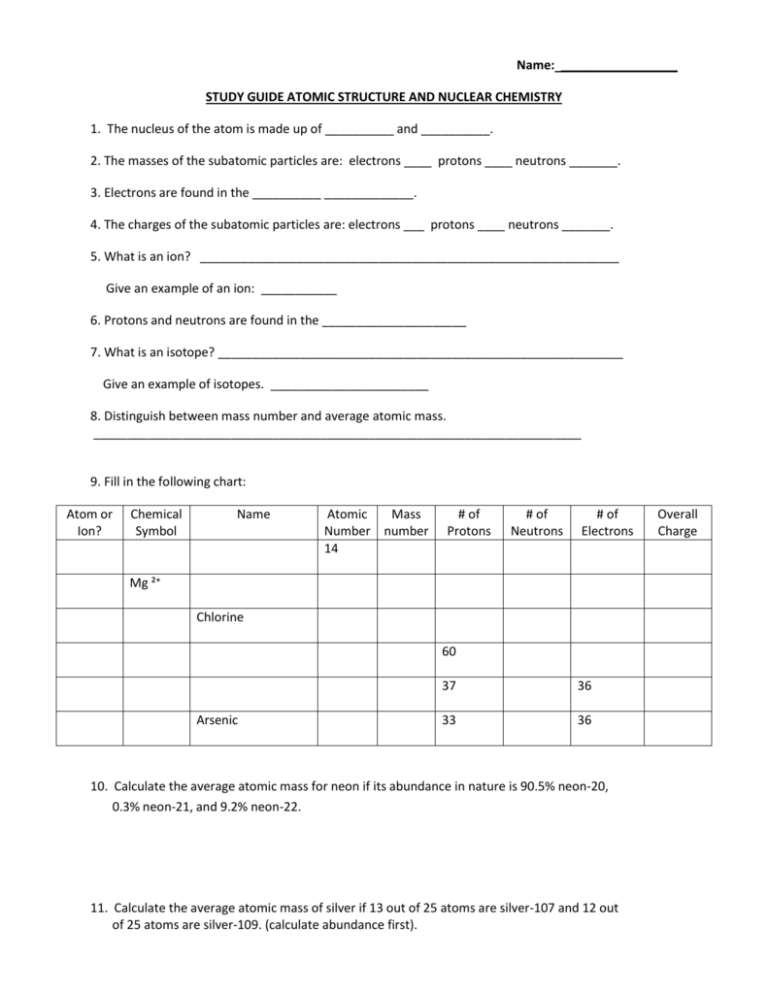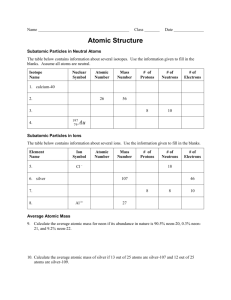study guide atoms
advertisement

Name: _________________ STUDY GUIDE ATOMIC STRUCTURE AND NUCLEAR CHEMISTRY 1. The nucleus of the atom is made up of __________ and __________. 2. The masses of the subatomic particles are: electrons ____ protons ____ neutrons _______. 3. Electrons are found in the __________ _____________. 4. The charges of the subatomic particles are: electrons ___ protons ____ neutrons _______. 5. What is an ion? _____________________________________________________________ Give an example of an ion: ___________ 6. Protons and neutrons are found in the _____________________ 7. What is an isotope? ___________________________________________________________ Give an example of isotopes. _______________________ 8. Distinguish between mass number and average atomic mass. _______________________________________________________________________ 9. Fill in the following chart: Atom or Ion? Chemical Symbol Name Atomic Mass Number number 14 # of Protons # of Neutrons # of Electrons Mg ²⁺ Chlorine 60 Arsenic 37 36 33 36 10. Calculate the average atomic mass for neon if its abundance in nature is 90.5% neon-20, 0.3% neon-21, and 9.2% neon-22. 11. Calculate the average atomic mass of silver if 13 out of 25 atoms are silver-107 and 12 out of 25 atoms are silver-109. (calculate abundance first). Overall Charge 12. What are the six parts of Dalton’s Atomic Theory? ______________________________________________________________________ ______________________________________________________________________ ______________________________________________________________________ ______________________________________________________________________ 13. Illustrate the Bohr Planetary Model of the atom and the electron cloud model of the atom. 14. Why do atoms undergo radioactive decay? _____________________________________________ 15. What will stop the following types of particles? Alpha _________ Beta ________ Gamma _______ 16. Write the nuclear symbol for Uranium-238: 17. Write an equation for the alpha decay of Uranium-239. 18. Write an equation for the beta decay of Bismuth-207. 19. What is the symbol for a gamma particle? ______ a Beta particle? _______ an Alpha particle? ____ 20. What is half-life? 21. An atom has a half-life of 12 years. If you start with a 500g sample, how much is left after 72 years? 22. What is the difference between fission and fusion? 23. Give an example of where fission reactions are used. _____________ Fusion reactions. __________ 24. Naturally occurring carbon consists of three isotopes, 12C, 13C, and 14C. State the number of protons, neutrons, and electrons in each of these carbon atoms. 12C 13C 14C 6 6 6 #P _______ _______ _______ #N _______ _______ _______ #E _______ _______ _______ 25. What does it mean if something is radioactive? __________________________________________ _____________________________________________________________________________________











